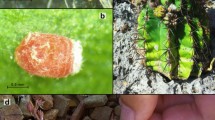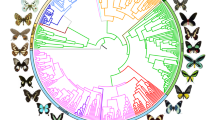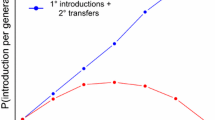Abstract
The phytophagous insects of the Tephritidae family commonly referred to as “true fruit flies” offer different case histories of successful invasions. Mankind has played an important role in altering the distributions of some of the more polyphagous and oligophagous species. However, the question arises why only a few species have become major invaders. The understanding of traits underlying adaptation in different environments is a major topic in invasion biology. Being generalists or specialists, along the K–r gradient of the growth curve, make a difference in term of food resources exploitation and interspecies competition and displacement. The species of the genus Ceratitis are good examples of r-strategists. The genetic and biological data of the most notorious Ceratitis species, the Mediterranean fruit fly Ceratitis capitata (medfly), are reviewed to investigate the traits and behaviours that make the medfly an important invader. It can be learnt from medfly, that invasions in a modern global trade network tend to be due to multiple introductions. This fact allows a maintenance or enhancement of genetic variability in the adventive populations, which in turn increases their potential invasiveness. Our current knowledge of the medfly genome opens the way for future studies on functional genomics.


Similar content being viewed by others
References
Aluja M, Norrbom AL (2000) Fruit flies (Tephritidae): phylogeny and evolution of behavior. CRC Press, Boca Ranton, Florida
Ashburner M (1998) Speculations on the subject of alcohol dehydrogenase and its properties in Drosophila and other fruit flies. BioEssays 20:949–954
Augustinos AA, Stratikopoulos EE, Zacharopoulou A, Mathiopoulos KD (2002) Polymorphic microsatellite markers in the olive fly, Bactrocera oleae. Mol Ecol Notes 2:278–280
Augustinos AA, Mamuris Z, Stratikopoulos EE, D’Amelio S, Zacharopoulou A, Mathiopoulos KD (2005) Microsatellite analysis of olive fly populations in the Mediterranean indicates a westward expansion of the species. Genetica 125:231–241
Back EA, Pemberton CE (1918) The Mediterranean Fruit Fly. USDA Bulletin No. 491, USDA, Washington DC, p 63
Baliraine FN, Bonizzoni M, Osir EO, Lux SA, Mulaa FJ, Zheng L et al (2003) Comparative analysis of microsatellite loci in four fruit fly species of the genus Ceratitis (Diptera: Tephritidae). Bull Entomol Res 93:1–10
Baliraine FN, Bonizzoni M, Guglielmino CR, Osir EO, Lux SA, Mulaa FJ et al (2004) Population genetics of the potentially invasive African fruit fly species, Ceratitis rosa and Ceratitis fasciventris (Diptera: Tephritidae). Mol Ecol 13:683–695
Bohonak AJ, Davies N, Villablanca FX, Roderick GK (2001) Invasion genetics of New World medflies: testing alternative colonization scenarios. Biol Invasions 3:103–111
Bonizzoni M, Malacrida AR, Guglielmino CR, Gomulski LM, Gasperi G, Zheng L (2000) Microsatellite polymorphism in the Mediterranean fruit fly, Ceratitis capitata. Insect Mol Biol 9:251–261
Bonizzoni M, Zheng L, Guglielmino CR, Haymer DS, Gasperi G, Gomulski LM et al (2001) Microsatellite analysis of medfly bioinfestations in California. Mol Ecol 10:2515–2524
Bonizzoni M, Katsoyannos BI, Marguerie R, Guglielmino CR, Gasperi G, Malacrida A, Chapman T (2002) Microsatellite analysis reveals remating by wild Mediterranean fruit fly females, Ceratitis capitata. Mol Ecol 11:1915–1921
Bonizzoni M, Guglielmino CR, Smallridge CJ, Gomulski LM, Malacrida AR, Gasperi G (2004) On the origins of medfly invasion and expansion in Australia. Mol Ecol 13:3845–3855
CABI/EPPO (1998) Distribution Maps of quarantine pests for Europe. CAB International, Wallingford, UK
Capy P, Gasperi G, Biemont C, Bazin C (2000) Stress and transposable elements: co-evolution or useful parasites? Heredity 85:101–106
Carey JR (1991) Establishment of the Mediterranean fruit fly in California. Science 253:1369–1373
Carey JR (1996) The incipient Mediterranean fruit fly population in California: implications for invasion biology. Ecology 77:1690–1697
Carey JR, Yang P, Foote D (1988) Demographic analysis of insect reproductive levels, patterns and heterogeneity: case study of laboratory strains of three Hawaiian tephritids. Entomol Exp Appl 46:85–91
Chen CC, Tseng YH (1992) Monitoring and survey of insect pests with potential to invade the Republic of China. Plant quarantine in Asia and the Pacific: Report of an APO Study Meeting, pp 42–52
Clarke AR, Armstrong KF, Carmichael AE, Milne JR, Raghu S, Roderick GK et al (2005) Invasive phytophagous pests arising through a recent tropical evolutionary radiation: the Bactrocera dorsalis complex of fruit flies. Annu Rev Entomol 50:293–319
Davies N, Villablanca FX, Roderick GK (1999) Bioinvasions of the medfly Ceratitis capitata: source estimation using DNA sequence at multiple intron loci. Genetics 153:351–360
De Breme F (1842) Note sur le genre Ceratitis de M. Mac Heay (Diptera). Ann Soc Entomol France 11:183–190
De Meyer M (2001a) Distribution patterns and host–plant relationships within the genus Ceratitis MacLeay (Diptera: Tephritidae) in Africa. Cimbebasia 17:219–228
De Meyer M (2001b) On the identity of the Natal fruit fly Ceratitis rosa Karsch (Diptera, Tephritidae). Entomologie 71:55–62
De Meyer M, Copeland RS, Wharton RA, McPheron BA (2002) On the geographical origin of the medfly, Ceratitis capitata (Wiedemann). Abstract presented at the 6th international symposium on fruit flies of economic importance, Stellenbosch, South Africa, 6–10 May 2002
Diaz-Fleischer F, Papaj DR, Prokopy RJ, Norrbom AL, Aluja M (1999) Evolution of fruit fly oviposition behavior. In: Aluja M, Norrbom AL (eds) Fruit flies (Tephritidae): phylogeny and evolution of behavior. CRC Press, Boca Ranton, Florida, pp 811–842
Duyck PF, David P, Quilici S (2004) A review of relationships between interspecific competition and invasions in fruit flies (Diptera: Tephritidae). Ecol Entomol 29:511–520
Eberhard WG (2000) Sexual behavior and sexual selection in the Mediterranenan fruit fly Ceratitis capitata (Dacine: Ceratitidini). In: Aluja M, Norrbom AL (eds) Fruit flies (Tephritidae): phylogeny and evolution of behavior. CRC Press, Boca Ranton, Florida, pp 459–489
Fimiani P (1989) Mediterranean region. In: Robinson AS, Hooper GH (eds) Fruit flies: their biology, natural enemies and control, vol 3A. Elsevier Science Publ, Amsterdam, Netherlands, pp 39–50
Fletcher BS (1989) Movements of tephritid fruit flies. In: Robinson AS, Hooper GH (eds) Fruit flies: their biology, natural enemies and control, vol 3B. Elsevier Science Publ, Amsterdam, Netherlands, pp 209–219
Frankham R (2003) Genetics and conservation biology. C R Biol 32:S22–29
Fritz AH, Schable N (2004) Microsatellite loci from the Caribbean Fruit Fly, Anastrepha suspensa (Diptera: Tephritidae). Mol Ecol Notes 4:443–445
Gasperi G, Guglielmino CR, Malacrida AR, Milani R (1991) Genetic variability and gene flow in geographical populations of Ceratitis capitata (Wied.) (medfly). Heredity 67:347–356
Gasperi G, Bonizzoni M, Gomulski LM, Murelli V, Torti C, Malacrida AR et al (2002) Genetic differentiation, gene flow and the origin of infestations of the medfly, Ceratitis capitata. Genetica 116:125–135
Gilchrist AS, Wang Y, Yu H, Raphael K, Gilchrist AS (2003) Genetic delineation of sibling species of the pest fruit fly Bactrocera (Diptera: Tephritidae) using microsatellites. Bull Entomol Res 93:351–360
Gomulski LM, Bourtzis K, Brogna S, Morandi PA, Bonvicini C, Sebastiani F et al (1998) Intron size polymorphism of the Adh1 gene parallels the worldwide colonization history of the Mediterranean fruit fly, Ceratitis capitata. Mol Ecol 7:1729–1742
Gomulski LM, Brogna S, Babaratsas A, Gasperi G, Zacharopoulou A, Savakis C, Bourtzis K (2004a) Molecular basis of the size polymorphism of the first intron of the Adh-1 gene of the mediterranean fruit fly, Ceratitis capitata. J Mol Evol 58:732–742
Gomulski LM, Torti C, Murelli V, Bonizzoni M, Gasperi G, Malacrida AR (2004b) Medfly transposable elements: diversity, evolution, genomic impact and possible applications. Insect Biochem Mol Biol 34:139–148
Hagen KS, William WW, Tassan RL (1981) Mediterranean fruitfly: the worst may be yet to come. Calif Agric 35:5–7
Haymer DS, He M, McInnis DO (1997) Genetic marker analysis of spatial and temporal relationships among existing populations and new infestations of the Mediterranean fruit fly (Ceratitis capitata). Heredity 79:302–309
Kaneshiro KI (2000) Sexual selection and speciation in Hawaiian Drosophila (Drosophilidae): a model system for research in Tepritidae. In: Aluja M, Norrbom AL (eds) Fruit flies (Tephritidae): phylogeny and evolution of behavior. CRC Press, Boca Ranton, Florida, pp 861–877
Katsoyannos P (1992) Olive pests and their control in the Near East. FAO Plant Production and Protection Paper No. 115, FAO Rome, Italy
Kidwell MG, Lisch DR (2000) Transposable elements and host genome evolution. Trends Ecol Evol 15:95–99
Kolbe JJ, Glor RE, Rodriguez Schettino L, Lara AC, Larson A, Losos JB (2004) Genetic variation increases during biological invasion by a Cuban lizard. Nature 431:177–181
Lee CE (2002) Evolutionary genetics of invasive species. Trends Ecol Evol 17:386–391
Lockwood JL, Cassey P, Blackburn T (2005) The role of propagule pressure in explaining species invasions. Trends Ecol Evol 20:223–228
MacArthur RH, Wilson EO (1967) The theory of island biogeography. Princeton University Press, Princeton
Malacrida AR, Guglielmino CR, Gasperi G, Baruffi L, Milani R (1992) Spatial and temporal differentiation in colonizing populations of Ceratitis capitata. Heredity 69:101–111
Malacrida AR, Guglielmino CR, D’Adamo P, Torti C, Marinoni F, Gasperi G (1996) Allozyme divergence and phylogenetic relationships among species of tephritid flies. Heredity 76:592–602
Malacrida AR, Marinoni F, Torti C, Gomulski LM, Sebastiani F, Gasperi G et al (1998) Genetic aspects of the worldwide colonization process of Ceratitis capitata. J Hered 89:501–507
McCollum AM, Ganko EW, Barrass PA, Rodriguez JM, McDonald JF (2002) Evidence for the adaptive significance of an LTR retrotransposon sequence in a Drosophila heterochromatic gene. BMC Evol Biol 19:2–5
McPheron BA, Sheppard WS, Steck GJ (1995) Genetic research and the origin, establishment, and the spread of the Mediterranean fruit fly. In: Morse JG, Metcalf RL, Dowell RV (eds) The medfly in California: defining critical research. Center for Exotic Pest Research, University of California, Riverside, pp 93–107
Meagher TR, Costich DE (2004) ‘Junk’ DNA and long-term phenotypic evolution on Silene section Elisanthe (Caryophyllaceae). Proc R Soc Lond B (suppl.) 271:493–497
Meixner MD, McPheron BA, Silva JG, Gasperich GE, Sheppard WS (2002) The Mediterranean fruit fly in California: evidence for multiple introductions and persistent populations based on microsatellite and mitochondrial DNA variability. Mol Ecol 11:891–899
Metcalf RL (1995) Biography of the Mediterranean fruit fly. In: Morse JG, Metcalf RL, Carey JR, Dowells RV (eds) The Mediterranean fruit fly in California: defining critical research. College of Natural and Agricultural Sciences, University of California, Riverside, CA
Myers J, Simberloff D, Kuris AM, Carey JR (2000) Eradication revisited: dealing with exotic species. Trends Ecol Evol 15:316–320
Nardi F, Carapelli A, Dallai R, Roderick GK, Frati F (2005) Population structure and colonization history of the olive fly, Bactrocera oleae (Diptera, Tephritidae). Mol Ecol 14:2729–2738
Nardon C, Deceliere G, Loevenbruck C, Weiss M, Vieira C, Biemont C (2005) Is genome size influenced by colonization of new environments in dipteran species? Mol Ecol 14:869–878
Nei M., Maruyama T., Chakraborty R (1975). The bottleneck effect and genetic variability in populations. Evolution 29:1–10
Novolseltsev VN, Carey RJ, Novoseltseva JA, Papadopoulos NT, Blay S, Yashin AI (2004) Systemic mechanisms of individual reproductive life history in female Medflies. Mech Ageing Dev 125:77–87
Raphael KA, Whyard S, Shearman D, An X, Frommer M (2004) Bactrocera tryoni and closely related pest tephritids – molecular analysis and prospects for transgenic control strategies. Insect Biochem Mol Biol 34:167–176
Reznick D, Bryant MJ, Bashey F (2002) r- and K selection revisited: the role of population regulation in life history evolution. Ecology 83:1509–1520
Rice RE, Phillips PA, Stewart-Leslie J, Sibbett GS (2003) Olive fruit fly populations measured in central and southern California. Calif Agric 57:122–127
Saki AK, Allendorf FW, Holt JS, Lodge DM, Molofsky J, With KA (2001) The population biology of invasive species. Annu Rev Ecol Syst 32:305–332
Sheppard WS, Steck GJ, McPheron BA (1992) Geographic populations of the Mediterranean fruit fly may be differentiated by mitochondrial DNA variation. Experientia 48:1010–1013
Silva JG, Meixner MD, McPheron BA, Steck GJ, Sheppard WS (2003) Recent Mediterranean fruit fly (Diptera: Tephritidae) infestations in Florida – a genetic perspective. J Econ Entomol 96:1711–1718
Steyskal GC (1982) A second species of Ceratitis (Diptera: Tephritidae) adventive in the New World. Proc Entomol Soc Wash 84:165–166
Torti C, Malacrida AR, Yannopoulos G, Louis C, Gasperi G (1994) Hybrid dysgenesis-like phenomena in the medfly, Ceratitis capitata (Diptera, Tephritidae). J Hered 85:92–99
Torti C, Gomulski LM, Malacrida AR, Capy P, Gasperi G (1997) Genetic and molecular investigations on the endogenous mobile elements of non-drosophilid fruitflies. Genetica 100:119–129
Vargas RI, Walsh WA, Kanehisa D, Stark JD, Nishida T (2000) Comparative demography of three Hawaiian fruit flies (Diptera: Tephritidae) at alternating temperatures. Ann Entomol Soc Am 93:75–81
Vieira C, Biémont C (2004) Transposable element dynamics in two sibling species: Drosophila melanogaster and Drosophila simulans. Genetica 120:115–123
Vieira C, Lepetit D, Dumont S, Biémont C (1999) Wake up of transposable elements following Drosophila simulans worldwide colonization. Mol Biol Evol 16:1251–1255
Vieira C, Nardon C, Arpin C, Lepetit D, Biémont C (2002) Evolution of genome size in Drosophila. Is the invader’s genome being invaded by transposable elements? Mol Biol Evol 19:1154–1161
Villablanca FX, Roderick GK, Palumbi SR (1998) Invasion genetics of the Mediterranean fruit fly: variation in multiple nuclear introns. Mol Ecol 7:547–560
Volff JN (2005) Genome evolution and biodiversity in teleost fish. Heredity 94:280–294
White IM, Elson-Harris MM (1992) Fruit flies of economic significance: their identification and bionomics. CAB International, Wallingford and ACIAR, Canberra
White IM, De Meyer M, Stonehouse JM (2000) A review of native and introduced fruit flies (Diptera, Tephritidae) in the Indian Ocean Islands of Mauritius, Réunion, and Seychelles. In: Price NS, Seewooruthun SI (eds) Proceedings, Indian Ocean Commission, regional fruit fly symposium, Indian Ocean Commission/European Union, Flic en Flac, Mauritius, pp 15–21
Whittier TS, Shelly TE (1993) Productivity of singly vs multiply mated female Mediterranean fruit-flies, Ceratitis capitata (Diptera: Tephritidae). J Kansas Entomol Soc 66:200–209
Yu H, Frommer M, Robson MK, Meats AW, Shearman DC, Sved JA (2001) Microsatellite analysis of the Queensland fruit fly Bactrocera tryoni (Diptera: Tephritidae) indicates spatial structuring: implications for population control. Bull Entomol Res 91:139–147
Yuval B, Hendrichs J (2000) Behavior of flies in the Genus Ceratitis. In: Aluja M, Norrbom AL (eds) Fruit flies (Tephritidae): phylogeny and evolution of behavior. CRC Press, Boca Ranton, Florida, pp 429–457
Author information
Authors and Affiliations
Corresponding author
Rights and permissions
About this article
Cite this article
Malacrida, A.R., Gomulski, L.M., Bonizzoni, M. et al. Globalization and fruitfly invasion and expansion: the medfly paradigm. Genetica 131, 1–9 (2007). https://doi.org/10.1007/s10709-006-9117-2
Received:
Accepted:
Published:
Issue Date:
DOI: https://doi.org/10.1007/s10709-006-9117-2




